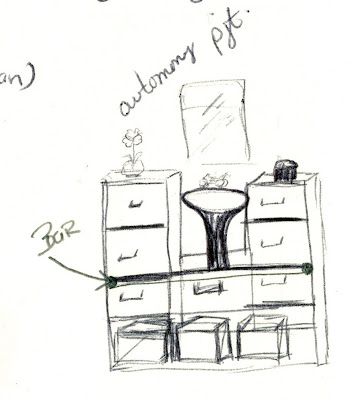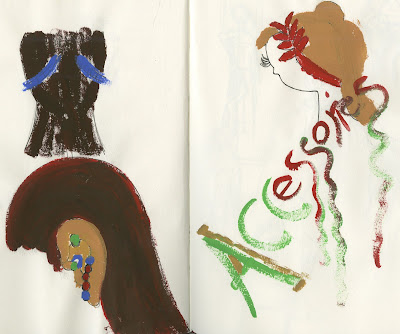Materials: Plywood, strap-pile from Lowe’s Home Improvement stores,Screws (silver),Nails (black), Decorative Nail heads, Wood glue, Wood Stain
Use of Materials:
The plywood was a poor choice. I used it because it was free; it was too late when Stoel warned us…I was already in too deep. The wood buckled which made measuring with 100% accuracy impossible. It also shattered or split when hammering.
The silver nails were an eye sore; therefore, I covered them with black nails and decorative nail heads to make it aesthetically pleasing.
The development:
Initially, I made a model from scrap foam board. I discovered a few missing components, such as, a place for the book (the ritual item to rest upon). Once I figured that out; I thought it was time to move on, but the dimensions were off quite a bit. The book didn’t fit. Disastrous! So I went to the sketchbook and reconfigured the measurements, which meant the object had become twice the size I had originally anticipated.
Once in the woodshop I quickly became accumulated with several of the machines, for time was of the essence. However, I had to revisit and revisit on several occasions due to the facts of the wood. The major area of concern was the sides of the box. The wood buckled in places that affected that opening space – the top measured at 2.25” and the bottom measured 2.38”, and this is where I needed to cut wood to insert the sides. Well, I cut it 3x’s for each side and never ended up with a perfect fit. I contemplated allowing the material to decide the design, but luckily discovered the claps. So I used wood glue as the binding agent and the claps to secure the fit and apply pressure over night. The next day I discovered that what I’d hoped for didn’t work. As I inspected the box and applied pressure in the areas of concern, I realized that reinforced pressure would make the wood cut for the sides fit. As I began to hammer the first nail, the face of the box slit, I paused with deep concern. I decided to continue, and the panel connected to the box by hinges split. I wanted to give up. I added some wood glue to that area and then applied another screw to that was a bit longer to help repair the dismantled panel.
Next item to tackle…the panels are not stopping, they swing beyond the desired point. I didn’t know how to approach it. It took several days, and I simply added a small strip of wood along the base of the opening and it worked.
To give the box an “old world” appearance and to add contrast, I decided to add a bit of dark wood stain. First to the panels…and then there comes a problem. The stain wasn’t dry before I over zealously began to open and shut them. As a result the small amounts of the stain bleed on the face of the box. I tried sanding, but it really tarnished the box. Then I bought a lighter wood stain (natural), not having any experience with this, I assumed it would fix the problem. Stoel discovered the mishap and introduced me to the chisel. That became the fix.
I decided to stain the face of the back piece of wood…so when the panels are opened there’d also be the dark wood (where book rests) Another accident…the wood stain appears on the back of the box. thought about leaving it there…but there was no rhyme or reason for it, so I stained the entire back side to the box. Happy accident as Tommy L likes to call it.








 The artist uses negative space to define objects and color to make give a bold contrast.
The artist uses negative space to define objects and color to make give a bold contrast.















